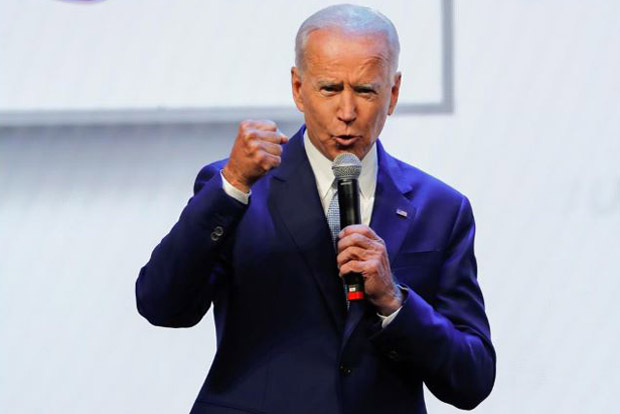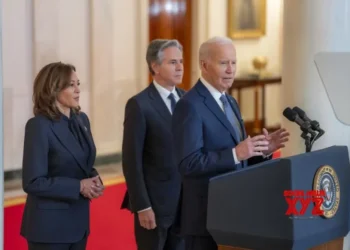Biden’s USD 6 trillion budget: Social spending, taxes on business
President Joe Biden on Saturday unveiled a USD 6 trillion budget for next year that’s piled high with new safety net programs for the poor and middle class, but his generosity depends on taxing corporations and the wealthy to keep the nation’s spiking debt from spiralling totally out of control.
Biden inherited record pandemic-stoked spending and won a major victory on COVID-19 relief earlier this year. Saturday’s rollout adds his recently announced infrastructure and social spending initiatives and fleshes out his earlier plans to sharply increase spending for annual Cabinet budgets.
This year’s projected deficit would set a new record of USD 3.7 trillion that would drop to USD 1.8 trillion next year — still almost double pre-pandemic levels. The national debt will soon breach USD 30 trillion after more than USD 5 trillion in already approved COVID-19 relief. As a result, the government must borrow roughly 50 cents of every dollar it spends this year and next.
With the deficit largely unchecked, Biden would use proposed tax hikes on businesses and high-earning people to power huge new social programs like universal prekindergarten, large subsidies for child care and guaranteed paid leave.
“The best way to grow our economy is not from the top down, but from the bottom up and the middle out,” Biden said in his budget message.
“Our prosperity comes from the people who get up every day, work hard, raise their family, pay their taxes, serve their Nation, and volunteer in their communities.”
The budget incorporates the administration’s eight-year, USD 2.3 trillion infrastructure proposal and its USD 1.8 trillion American Families Plan and adds details on his USD 1.5 trillion request for annual operating expenditures for the Pentagon and domestic agencies.
Acting White House budget chief Shalanda Young said the Biden plan “does exactly what the president told the country he would do. Grow the economy, create jobs and do so responsibly by requiring the wealthiest Americans and big corporations to pay their fair share.”
Biden’s budget is sure to give Republicans fresh ammunition for their criticisms of the new Democratic administration as bent on a “tax and spend” agenda that would damage the economy and impose a crushing debt burden on younger Americans. Republicans also say he’s shorting the military.
“It is insanely expensive. It dramatically increases nondefense spending and taxes” and would weaken the Pentagon, said South Carolina Sen. Lindsey Graham, top Republican on the Budget Committee and a generally pragmatic GOP voice on spending bills.
“There will be serious discussions about government funding. But the Biden budget isn’t serious and it won’t be a part of those discussions.”
Veteran GOP Sen Richard Shelby, whose help is needed to pass annual agency budget bills, blasted Biden’s plan as “a blueprint for the higher taxes, excessive spending” that also “shortchanges our national security.”
Biden is a veteran of a long-gone Washington that fought bitterly in the 1980s and 1990s to wrestle the deficit under control. But there hasn’t been any real effort to stem the flow of red ink since a tea party-driven moment in 2011 that produced unpopular automatic spending cuts that were largely reversed over the ensuing decade.
Huge deficits have yet to drive up interest rates as many fiscal hawks have feared, however, and genuine anti-deficit sentiment is difficult to find in either political party.
The unusual timing of the budget rollout — the Friday afternoon before Memorial Day weekend — indicates that the White House isn’t eager to trumpet the bad deficit news.
Under Biden’s plan, the debt held by the public would quickly match the size of the economy and soon eclipse record levels of debt relative to gross domestic product that have stood since World War II. That’s despite more than USD 3 trillion in proposed tax increases over the decade, including an increase in the corporate tax rate from 21 per cent to 28 per cent, increased capital gains rates on top earners and returning the top personal income tax bracket to 39.6 per cent.
Like all presidential budgets, Biden’s plan is simply a proposal. It’s up to Congress to implement it through tax and spending legislation and annual agency budget bills. With Democrats in control of Capitol Hill, albeit barely, the president has the ability to implement many of his tax and spending plans, though his hopes for awarding greater increases to domestic agencies than to the Pentagon are sure to hit a GOP roadblock.
Some Democrats are already balking at Biden’s full menu of tax increases, imperiling his ability to pay for his ambitious social spending. And his plan to increase spending on domestic agencies by 16 per cent while limiting defense to a 1.7 per cent rise is politically impossible in the 50-50 Senate.
A top Senate ally, Appropriations Committee Chairman Patrick Leahy, D-Vt., called Thursday for bipartisan talks to start the annual appropriations bills. There’s incentive for both GOP defense hawks and liberal Democrats like Leahy to bargain since the alternative is a long-term freeze at current spending levels.
The Biden plan comes as the White House is seeking an agreement with Senate Republicans over infrastructure spending. But winning gains that would even begin to meet his social spending goals would require him to rely solely on support from his narrow Democratic majorities in Congress.























